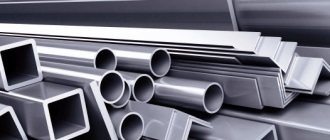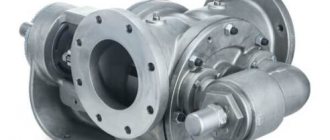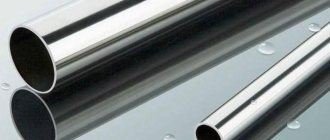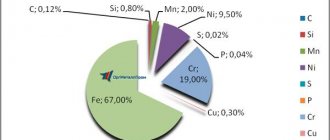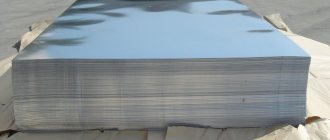Classification of properties
For all structural materials of the metal group in the Russian Federation, a classification of their characteristics is used according to four main criteria:
· physical characteristics - weight and fusibility, color and expandability, magnetization and electrical conductivity, thermal conductivity;
· chemical properties - solubility, corrosion resistance and oxidation;
· mechanical characteristics - plasticity, viscosity, strength, elasticity and hardness;
· technological properties - malleability and hardenability, weldability and machinability, fluidity.
Additionally, stainless steels are classified within their own steel category according to the following characteristics:
· corrosion-resistant – do not rust under atmospheric conditions;
· heat-resistant – do not oxidize at high temperatures and do not form scale;
· heat-resistant – work for a long time under load at high temperatures;
· acid-resistant – do not rust in acidic environments;
· cold-resistant – retain viscosity at subzero temperatures.
Basically, 321 steel is 304 stainless steel with the addition of 0.5% titanium. Which corresponds to domestic analogues 08Х18Н10 and 08Х18Н10Т.
Chemical composition
Stainless steel differs from carbon steel in its chromium content.
Unprotected carbon steel will immediately rust when exposed to air and moisture. This film of iron oxide (rust) is active and accelerates corrosion by making it easier to create more iron oxide. Because iron oxide has a lower density than steel, the layer expands and tends to flake and fall off. Stainless steels, however, contain enough chromium to passivate, creating an inert layer of chromium oxide on the surface. This layer prevents further corrosion by blocking the diffusion of oxygen to the surface of the steel and stops corrosion from spreading throughout most of the metal. Passivation occurs only with a sufficiently high chromium content and in the presence of oxygen. When choosing the chemical composition of a corrosion-resistant alloy, they are guided by the so-called rule N8{\displaystyle {\frac {N}{8}}}: if a metal that is unstable to corrosion (for example, iron) is added to a metal that forms a solid solution with it and is resistant to corrosion (for example, chromium), then the protective effect appears abruptly with the introduction of 18,28,38...N8{\displaystyle {\frac {1}{8}},{\frac {2}{8}},{\frac { 3}{8}}…{\frac {N}{8}}} moles of the second metal (corrosion resistance increases not in proportion to the amount of the alloying component, but in an abrupt manner). The main alloying element of stainless steel is chromium Cr (12-20%); in addition to chromium, stainless steel contains elements accompanying iron in its alloys (C, Si, Mn, S, P), as well as elements introduced into steel to give it the necessary physical and mechanical properties and corrosion resistance (Ni, Mn, Ti, Nb, Co, Mo).
The corrosion resistance of stainless steel directly depends on the chromium content: with a chromium content of 13% and above, the alloys are stainless under normal conditions and in mildly aggressive environments, more than 17% are corrosion-resistant in more aggressive oxidizing and other environments, in particular, in nitric acid with a strength of up to 50 %.
The reason for the corrosion resistance of stainless steel is explained mainly by the fact that a thin film of insoluble oxides forms on the surface of a chromium-containing part in contact with an aggressive environment, and the condition of the surface of the material, the absence of internal stresses and crystalline defects, is of great importance.
In strong acids (sulfuric, hydrochloric, phosphoric and their mixtures), complex alloys with a high Ni content and Mo, Cu and Si additives are used.
Increased atmospheric corrosion resistance of steel is achieved, as a rule, by purposefully changing its chemical composition. It is believed that small additions of nickel, chromium and, especially, phosphorus and copper increase the resistance of building steels to atmospheric corrosion most effectively. Thus, alloying with copper in the range of 0.2–0.4% increases the corrosion resistance of open structures in an industrial atmosphere by 20–30%.
Physical properties
Chromium-nickel austenitic stainless steel AISI 321 has the following physical type characteristics:
· specific heat capacity – 504 J/kg*°C;
· fusibility – stainless steel AISI 321 melts at +1400°С ... +1455°С;
· electrical resistance – 1.5*10-6 Ohm*m;
· weight – AISI 321 density 7900 kg/m3;
· thermal conductivity – coefficient for AISI 321 stainless steel is 17 W/m*°C;
· expandability – AISI 321 stainless steel has a linear expansion coefficient of 16 – 18 1/°С;
· magnetization – AISI 321 material does not contain ferrite in its structure, does not have magnetic properties;
· color – steel grade AISI 321 has a steel color;
· electrical conductivity – AISI 321 steel has an indicator of 1 – 1.2%IACS;
In the three hundredth austenitic series of corrosion-resistant alloys, AISI 321 stainless steel, by analogy with standard 304, can be called both food and medical stainless steel. Because it is used to make dishes, milk couplings, surgical instruments, and medical autoclaves.
The surface of the metal does not need to be chromed or nickel plated, since both of these metals are already present in the structure of the 321 alloy. Therefore, rolled pipes are widely used in construction, finishing of facade exteriors and interior interiors.
Stainless steel AISI 321 in StenlisPro
StenlisPro is a company operating in the rolled metal market since 2010, selling products made from high-quality AISI 321 stainless steel:
- sheets AISI 321 – thickness from 0.5 to 2.0 mm, matte surface;
- stainless steel circles calibrated matte AISI 321.
The alloy is not hardened, it is non-magnetic, and lends itself well to hot processing. Thus, when carrying out welding work, there is no need for additional heating of the metal, and the weld also does not require additional processing.
If you are interested in the purchase, delivery, cutting of goods made of AISI 321 stainless steel, as well as consulting services, please call. You can order a free call on the company’s website, our employee will contact you on the same day.
Mechanical properties
The mechanical characteristics of steel for AISI 321 correspond to the following values:
· elasticity – elastic modulus 193 GPa;
· ductility – relative elongation 40%;
· viscosity – yield strength 205 MPa;
· strength – fatigue 240 N/mm2, tensile strength 515 MPa;
· hardness – 170 Brinell units.
A short 30 cm rod of stainless steel 321 with a thickness of 8 mm can be bent by hand, since the hoist is quite soft. During turning, chips are removed easily, with low energy consumption and labor costs. The thread has a smooth profile, without torn edges or burrs. However, AISI 321 threaded connections are most often disposable - with a high tightening force, the thread profile is deformed.
AISI 321 GOST taxes are applied to two construction materials at once - 12Х18Н10Т and 08Х18Н10Т. For AISI 321 steel, the standard includes its only modification 321H with an extended carbon content range.
Performance at elevated temperatures
| Yield strength in, MPa | 5 | 25 | 50 | 80 | 120 |
| Yield strength a, MPa | 10 | 40 | 70 | 100 | 180 |
| Temperature, °C | 800 | 700 | 650 | 600 | 550 |
| Tensile strength, MPa | 140 | 190 | 230 | 280 | 329 | 390 |
| Temperature, °C | 850 | 800 | 750 | 700 | 650 | 600 |
Technological properties
Taking into account the chemical composition of AISI 321 steel and its mechanical, physical, chemical characteristics, the technological properties of the structural material are as follows:
· malleability – low;
· hardenability – low;
· fluidity – low;
· cutting machinability – high;
· weldability – without restrictions and preheating of edges.
AISI 321 steel is welded with special electrodes of the 347 series, stabilized with niobium. Welds are cleaned and passivated to prevent corrosion in the heat-affected zone.
AISI 321 material is annealed in the temperature range +1050°C ... +1150°C, followed by cooling in air. The tempering temperature is +450°С ... +800°С. For passivation, a temperature of +20°C and a HNO3 solution of 25% concentration are used.
The specified chemical composition for AISI 321 with a chromium and nickel ratio of 18/8 provides a rational combination of strength characteristics, production costs, anti-corrosion properties and product life.
Stainless steel 321 characteristics - Metalist's Handbook
/ Directory of rolled metal products / Stainless steel rolled products /
Brief information
Brand AISI 321 —
Corrosion-resistant, heat-resistant, heat-resistant steel. Unstable in sulfur-containing environments. The recommended operating temperature is 600-800°C, and the operating life is very long.
AISI 321
is not subject to intergranular corrosion even when welding in mildly corrosive environments due to the addition of titanium to form a hard alloy.
However, welded 321 should never be used in highly oxidizing environments.
Application area
It is used for the manufacture of welded equipment in various industries (pipes, parts of furnace fittings, heat exchangers, muffles, retorts, pipes and manifolds of exhaust systems, spark plug electrodes).
Chemical Composition (ASTM A240)
| C | Mn | P | S | Si | Cr | Ni | Ti | |
| ASTM A240 | 0.08max | 2.0max | 0.045 max | 0.030 max | 1.0max | 17.0 — 19.0 | 9.0 — 12.0 | 5X%C min 0.5 max |
| Typical | 0.06 | 1.2 | 0.020 | 0.020 | 0.5 | 17.5 | 9.4 | 0.48 |
Typical Properties in Annealed State
The properties stated in this publication are typical of one plant's production and should not be regarded as guaranteed minimum values for the entire specification.
Mechanical Properties at room temperature
| Typical | Minimum | |
| Rp m Ultimate strength (tensile), N/mm2 | 580 | 515 |
| Rp0.2 Elastic Limit, (0.2 %),(yield),N/mm2 | 280 | 205 |
| A80 elongation to break % | 60 | 40 |
| Brinell hardness - HB | 163 | — |
| Fatigue strength, N/mm2 | 260 | — |
Tensile strength at elevated temperatures
| Temperature, oC | 600 | 650 | 700 | 750 | 800 | 850 |
| Rp m Ultimate strength (tensile), N/mm2 | 390 | 329 | 280 | 230 | 190 | 140 |
Minimum values of Elastic Limit at high temperature (1% deformation for a specified time at a given temperature)
| Time | Temperature, oC | 550 | 600 | 650 | 700 | 800 |
| 10,000 h | Rp1.0 1.0% plastic deformation (yield), N/mm2 | 180 | 100 | 70 | 40 | 10 |
| 100,000 h | Rp1.0 1.0% plastic deformation (yield), N/mm2 | 120 | 80 | 50 | 25 | 5 |
Elastic (yield) limit before rupture
| Time | Temperature oC | 500 | 600 | 650 | 700 | 800 |
| 1 000 h | Stress MPa | 270 | 180 | 140 | 70 | 30 |
| 10 000 h | Stress MPa | 240 | 130 | 90 | 50 | 10 |
| 100,000 h | Stress MPa | 200 | 90 | 50 | 15 | 5 |
Maximum recommended Service Temperature (scale formation temperature)
Continuous exposure 900oC intermittent exposure 810oC
Heat Treatment
1. Annealing -
temperatures from 1050 to 1150oC and rapid cooling in cool air. This guarantees maximum flexibility of the steel.
2. Vacation (Stress Relief)
— annealing within 450-800 oC without the appearance of carbide precipitation, thus avoiding the possibility of intergranular corrosion.
3. Forging interval
Initial temperature: 1150 - 1250oC
Final temperature: 950 oC Please note: The time to achieve uniform heating is longer for stainless steel. steels than for carbon steels - approximately 12 times.
A gradual decrease in temperature is required to ensure carbon distribution
AISI 321
AISI 321 stainless steel is a non-magnetic structural steel. Distinctive characteristics - increased resistance to corrosion, heat resistance, heat resistance.
Prices for AISI 321
Popular categories:
Other varieties:
Application of AISI 321
Russian analogue of AISI 321 (GOST 19903-74 and 19904-90), used in construction, chemical, oil refining, food industries, mechanical engineering, aviation.
Used as raw material for the manufacture of equipment intended for operation at high temperatures.
You can order products from this steel grade online on the BETALL website.
Production of stainless steel AIZI 321
The unique properties that distinguish this brand of stainless steel are provided by the alloy composition, which includes chromium (17–19%), nickel (9–11%), and titanium. It is precisely because of the presence of expensive nickel in the composition that the price of products is an order of magnitude higher than that of other stainless steel products. AIZI 321 is hardened at a temperature of 1020-1100°C, followed by rapid cooling in air or water.
For forming, the same equipment and operations are used as for carbon stainless steel, namely: contour forming, drawing, drawing, bending.
Basic tech. characteristics - strength, resistance to extreme operating conditions. The maximum permissible temperature for long-term exposure is 810°C, short-term - 900°C.
The hardness of stainless steel is HB 10 -1 = 179 MPa. Resistant to corrosion (MCC), chemical environments: dilute alkaline solutions, organic acids, neutral and alkaline salt solutions, most organic environments.
12x18n10t is perfectly weldable and is characterized by high ductility, due to which the steel is used to create products of various shapes. Tapes and rolled steel are ideal for these purposes.
Features and range of aisi 321
The analog AISI321 12x18n10t contains titanium, which is why the weldability of this grade is somewhat worse than that of stainless steel 304 and 304L. For welding, it is recommended to use Nb-stabilized electrodes (347 series). Post-welding treatment is reduced to mechanical descaling and passivation.
BETAL's assortment includes finished products from this brand - stainless steel pipes, forgings, circles, rods, tape, wire. For enterprises engaged in the production of industrial equipment, we offer wholesale sales of stainless steel sheets, incl. in the form of rolls.
Storage and transportation of AISI 321
It is stored in closed warehouses to protect products from the negative influence of atmospheric phenomena and to prevent mechanical damage. Each batch of goods must be supplied with certificates, labeling with full information about the class of the product, its compliance with GOST, and other data.
The Betall company offers not only the production and sale of rolled metal, but also delivery of orders directly to the site (Moscow, Moscow region, other regions of Russia - by agreement). Pickup from the warehouse is possible.
Placing an orderCheck availability and price by calling 8 (495) 78-555-48 or on the website (via the feedback form). Place an order, after which we will draw up a delivery agreement.
Payment Pay for the cost of the goods using one of the convenient methods: by bank transfer or in cash. For regular customers, deferred payment is possible.
Delivery or pickup Agree on the date of delivery/shipment from the warehouse. Can be delivered by railway and road transport. Special equipment can be dispatched.
Acceptance and unloadingThe order price includes 1 (one) hour for unloading by the buyer. After unloading, you will receive a complete set of documents.
About company
Has been actively working in the metal products market for more than 14 years. The professionalism of our employees, passion, responsibility, thoughtfulness of actions, the desire to offer you the best solutions to your problems - this is what characterizes us as a worthy partner capable of satisfying the needs of the most demanding client.
- LLC "BETALL" - 14 years of experience in the market
- Attentive approach to your needs
- Flexible pricing system
- Additional services
- Prompt shipment and delivery
- Guarantee of quality and safety during transportation
- Pre-sale preparation
- Labeling, sorting, packaging

